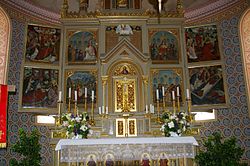Chancel flowers


Chancel flowers (also known as altar flowers) are flowers that are placed in the chancel of a Christian church.[1] These chancel flowers are often paid for by members of a congregation as an offering of thanksgiving to God.[2] Chancel flowers are often placed upon or adjacent to the altar table, as well as near other church furniture in the chancel, such as the baptismal font, lectern and pulpit.[2]
Chancel flowers are sometimes dedicated to the memory of someone who has died by the purchasing family.[3] Certain species of flowers are used during the various liturgical seasons of the Christian Kalendar, such as poinsettias during Christmastide (symbolic of the Star of Bethlehem) and Easter lilies during Eastertide (symbolic of the resurrection of Jesus).[4][5]
Many historic Christian denominations, such as the Methodist Churches, only permit live flowers upon the chancel:[6]
Since flowers symbolize the resurrection, and in keeping with the principle of integrity, no type of artificial flower or plant is appropriate to the environment of worship." The "principle of integrity" means that "everything should express to the worshiper the qualities of truth, integrity, simplicity, and purity. Anything that expresses falseness or pretence, or that is gaudy or cheaply ornate, should be avoided. —United Methodist Altars: A Guide for the Congregation[6]
The Catholic Church likewise teaches that “the use of living flowers and plants, rather than artificial greens, serves as a reminder of the gift of life God has given to the human community.”[7]
References[edit]
- ^ Wilson, Adelaide B.; Wilson, Lois (1967). Flowers for Your Church. M. Barrows. p. 26.
- ^ a b Guidelines for Protestant Women of the Chapel. United States Department of Defense Armed Forces Chaplains Board. 1965. p. 17.
- ^ "Flowers for the Altar". Saint Timothy's Episcopal Church. Retrieved 10 April 2020.
- ^ Caviness, Crystal. "The poinsettia: Jesus' life story in a plant". United Methodist Church. Retrieved 27 January 2020.
- ^ Collins, Cynthia (19 April 2014). "Easter Lily Tradition and History". The Guardian. Retrieved 20 April 2014.
The Easter Lily is symbolic of the resurrection of Jesus Christ. Churches of all denominations, large and small, are filled with floral arrangements of these white flowers with their trumpet-like shape on Easter morning.
- ^ a b "Are there guidelines for placing flowers in the sanctuary?". The United Methodist Church. Retrieved 10 April 2020.
- ^ Doyle, Kenneth (21 September 2015). "Are artificial flowers allowed on the altar?". Crux. Retrieved 10 April 2020.
